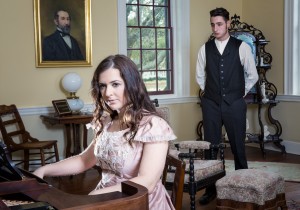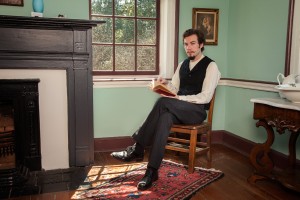In April, Assistant Professor of Art Chris Jordan’s students in Advanced Digital Photography class (Art 428) made history come alive. Students Brian Burkhard, Dana Cottone, Caroline Godwin, Chi Pan and Yanbing Wu created and photographed historically accurate scenes in UA’s Gorgas House Museum as a course assignment. They worked with museum director Lydia Ellington and Theatre and Dance Costume Manager Todd Roberts to research and develop nineteenth-century characters and set up scenes with actors in period dress. The Gorgas House is the oldest structure still standing on The University of Alabama campus, built in 1829. The Gorgas family lived there from 1879 into the 1950s. Three UA students, Sam Hardy, Jon Headrick and Dana Cottone posed for photographs as nineteenth-century characters who might have lived in the historic home.

Under Jordan’s direction, his students set up all aspects of production. Along with researching the characters, they surveyed the Gorgas House location to determine likely places for photographs and best vantage points. They decided on camera lenses and angles, lighting design and the assembly of the finished images on the computer.


Professor Jordan explained the assignment: “This was an exercise in ‘directorial mode’ photography in which fictional realities are staged for the camera. Photography can be used to ‘authenticate’ fictional stories quite convincingly. In class we looked at the work of Cindy Sherman, Jeff Wall, Gregory Crewdson and others for inspiration. Looking at these artists prompted conversations about photographic lighting, composition, and narrative tone. We wanted to move beyond merely lighting the space for illumination. Questions arose about how active a ‘voice’ we wanted the light to have–should we use strong, theatrical lighting that brings attention to the artifice, or something more subtle and nuanced, more natural. I think the images reflect these different approaches: some seem to be more passive and natural, for instance taking advantage of natural light; while others seem like they could be on a stage in a theatre, with more active lighting directions. It was a great exercise on many levels, conceptually, technically and aesthetically.”



IMAGE CREDIT: (above, left to right) Olive Elizabeth Kennedy (girl on right); Hiram Kennedy Douglass in college; Olive Elizabeth Kennedy. The historical photos are reproduced courtesy of the collection of the Gorgas House Museum. All other photos in this group are ©2015 Art 428, Department of Art and Art History.
View all four final student photos and shots of their set up in a slideshow on our Flickr.com pages.
For more information about photography and digital media or other areas in the Department of Art and Art History go to https://art.ua.edu/academics/photography/ or contact the department at (205) 348-5967.